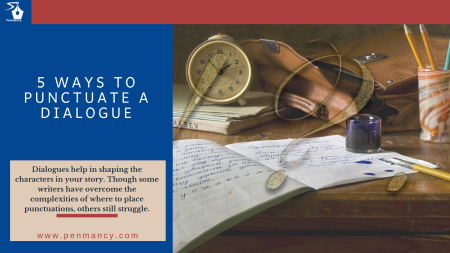
Punctuating dialogues might seem a minor part in fiction writing, a no-brainer, but it plays a crucial role in making sure that dialogue exchanges between your characters make sense to your readers. However, some writers find punctuating dialogue confusing.
This article will focus on the different ways to punctuate a dialogue. But before we proceed, kindly note that most dialogue sentences comprise of two parts: the dialogue, which is the spoken portion of the sentence, and then the dialogue tag, which identifies the speaker.
“I need a long vacation,” said Sunil.
- Dialogue: “I need a long vacation,”
- Dialogue tag: said Sunil.
Here are the five ways to punctuate a dialogue:
1. Punctuating a sentence that starts with the dialogue tag:
Keren said, “Take this newspaper to your dad.”
- Comma before the opening quotation mark. (, “)
- Capital letter to indicate the beginning of a sentence inside the opening quotation mark. (Take)
- A period before the last quote mark. (.”)
- Closing quotation mark. (”)
2. Punctuating when the dialogue tag is placed at the end of the sentence:
“Take this newspaper to your dad,” Keren said.
- Capital letter to indicate the beginning of a sentence inside the opening quotation mark.
- A comma to end the quoted sentence before the closing quotation mark that precedes the dialogue tag.
- Dialogue tag at the end with a period to end the sentence.
3. Punctuating when the dialogue tag separates two sentences of quoted speech:
“Call Jack tonight,” Mira said. “Have a good day.”
- Remember the bullet points above.
- The second piece of quoted material (Have a good day) appearing on the same line as the first to indicate that the same person/speaker said both pieces of quoted material, even though the second piece of quoted material does not have a dialogue tag.
4. Punctuating when the dialogue tag is placed in the middle:
“Call Jack,” Mira said, “tonight.”
- Remember the above-mentioned points.
- Comma after the dialogue tag or before the second opening quotation mark.
- Lower case letter (tonight) to indicate the second piece of the quotation is still a part of the sentence that began in the first piece of the quotation. Now observe: “Call me,” Mira said. “Tonight.” “I will,” Ben answered.
- Putting the dialogue tag in the middle and punctuating each quoted piece as separate sentences indicate a slight pause between Mira’s directing Ben to call her and when she would actually want to be called. Mira says to call her but then adds “Tonight” either as an afterthought or in order to emphasize that she does not want Ben to call Jack now.
- A period (.) after the dialogue tag but before the closing quotation mark (“) –always.
- Upper case letter (Tonight) to indicate the beginning of a sentence inside the next opening quotation mark.
5. Punctuating when a dialogue ends with an exclamation point (!) or a question mark (?)
Examples:
“Where have you been?” Jenny asked.
“I told you metal can’t go in the microwave!” she screamed.
- An exclamation point (!) or a question mark (?) is placed inside the quotation marks (“ ”).
- A comma is not added after the punctuation marks; only the end quotation mark (”) followed by the dialogue tag.
- If a statement ends in a quoted question, allow the question mark within the quotation marks suffice to end the sentence.
Ayush looked at me and asked, “Are you alright?”
Here, Are you alright itself is a question and must have a question mark before the end quotation mark.
- On the other hand, if a question ends with a quoted statement that is not a question, the question mark will go outside the closing quotation mark.
Did your father really say, “You’re not my son”?
Here, You’re not my son is a statement, not a question.
Notes:
- No comma is needed when you introduce texts using a conjunction, such as that or whether. Example: The message says that “you are a moron.”
- Use comma and closing quotation mark (,”) if and only if the dialogue tag is related to the dialogue. Example: “You are a liar,” Mona snapped. However, if the next line after the dialogue is a different statement altogether, only a period (.) before the closing quote is needed. Example: “You are a liar.” Mona walked away. (Here, ‘walked away’ is an action that is not related to the dialogue ‘You are a liar.’
That’s it. You are ready to punctuate those dialogues in your story. If you find this article helpful or if you need clarification, comment below.
